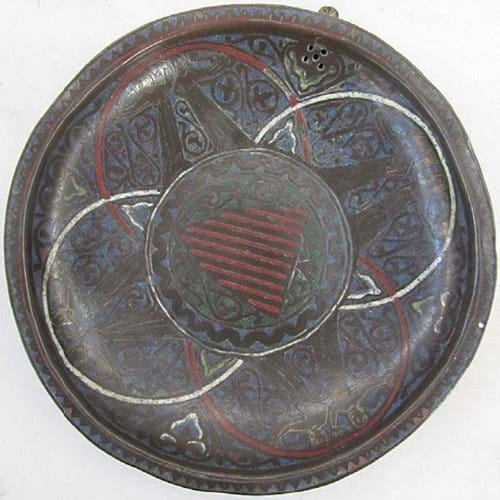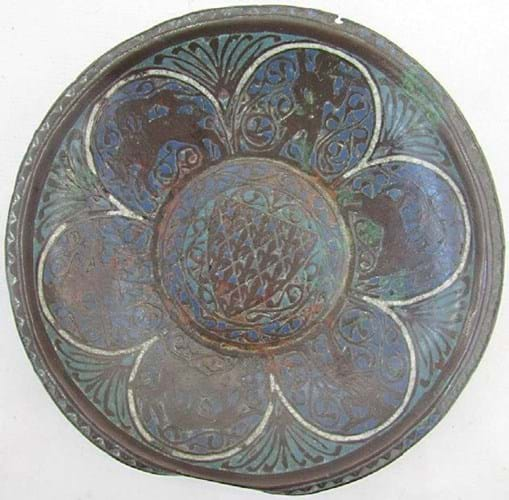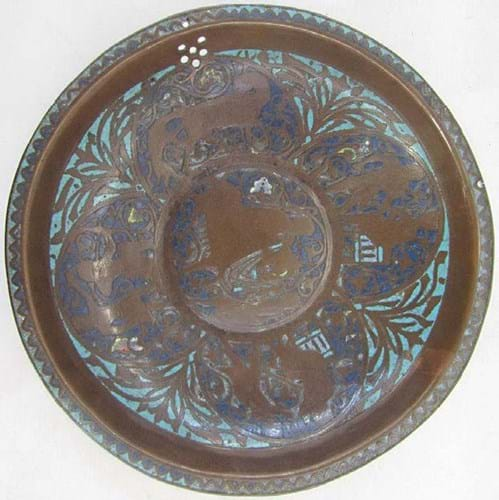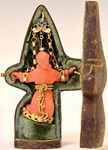
One of four early to mid 13th century Limoges enamel gemellions or basins for washing hands which were offered at the Cotswold Auction Company. It sold for £23,000.
In the 16th and 17th centuries practitioners of the craft included the de Court, Reymond and Penicault families who produced finely painted and fired Renaissance and Mannerist masterworks that were tours de force in this medium.
But the history of enamel work in this area extends much further back, to the early medieval period. Pieces such as reliquary chasses, croziers and other religious items were often made using champlévé enamelled decoration as well as secular items.

A detail of one of the four early to mid 13th century Limoges enamel gemellions or basins for washing hands sold at the Cotswold Auction Company, showing the spout.
Hever Castle link
The gemellion is a shallow dish made for washing hands at the table when dining during medieval times.
It derives from the Latin word for twin because these dishes were used in pairs – one fitted with a spout through which water could be poured over the hands, the other a shallow bowl for catching the water.
On December 12 the Cotswold Auction Company (24% buyer’s premium) offered a group of four of these medieval gilt copper Limoges gemellions in its Christmas sale in Cheltenham.
They dated from the first half of the 13th century and measured approximately 9in (23cm) in diameter. Offered from a private collection, they had a provenance by repute to Hever Castle in Kent, (which dates back to the 14th century and was the childhood home of Anne Boleyn), passing by descent to the vendor.
Gemellions often have armorials in their decoration and this was the case with three of these examples, although each was different and featured elements that are also replicated on other gemellions in the collections of major museums like the Louvre, the Metropolitan Museum and the British Museum.
All four had some losses and wear to the enamelwork commensurate with their age. They were offered individually each with an estimate of £7000-10,000. On sale day two different phone bidders battled to secure them.
Call to arms
The first to be offered (pictured top), which featured a partly gilded beast’s head spout to the underside, was enamelled to the centre with the arms of Provence within a border depicting four pairs of figures and made £23,000.

One of four early to mid 13th century Limoges enamel gemellions or basins for washing hands which were offered at the Cotswold Auction Company. It sold for £15,500.
The second had a central shield-shaped armorial referencing the Angevin Empire and the House of Plantagenet, which ruled over large parts of France and the British Isles at the time. It was surrounded by six further shield-shaped coats-of-arms including those for the provinces of Lusignan, Turenne and Provence which also appear on a gemellion in the Met, New York.
This realised £15,500.

One of four early to mid 13th century Limoges enamel gemellions or basins for washing hands which were offered at the Cotswold Auction Company. It sold for £27,000.
The third, featuring a central shield-shaped escutcheon with the French Royal Arms bordered by six panels of huntsmen and hunting scenes, a combination seen on an example in the Louvre, was the most expensive at £27,000.

One of four early to mid 13th century Limoges enamel gemellions or basins for washing hands which were offered at the Cotswold Auction Company. It sold for £10,000.
The fourth, which originally also featured a spout that was now missing, was decorated with a central equestrian figure and attendant within a border of four panels with pairs of figures and animals including a musician, an archer and a stag hunt. This went for £10,000.














